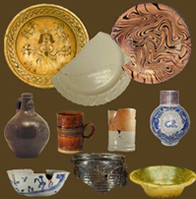
|
|
Agateware Defining Attributes Agateware is characterized by the use of a variegated ceramic paste created by mixing two or more different color clays. ftn1 Produced in both stoneware and earthenware, agateware falls into two broad types: thrown agateware and laid agateware. Chronology Potters manufacturing agateware mixed clays of differing colors in an attempt to create the look of agate, a semiprecious stone. Agateware can be classified into two main types: thrown agate and laid agate (Erickson and Hunter 2003). The difference in these two types lies primarily with the initial preparation of the clay and with how the clay is manipulated to form the vessel. These differences are summarized in the Description section below. The 2003 article “Swirls and Whirls: English Agateware Technology” by Michelle Erickson and Robert Hunter contains an excellent discussion and photographs of the production processes for both types of agateware, as well as a more extended historical perspective. Thrown Agateware - The earliest documented agateware was produced as thrown stoneware by John Dwight in the 1670s and was also made later in the century by Francis Place of York (Erickson and Hunter 2003: 87, 90; Edwards and Hampson 2005:12). Larger-scale commercial production of agateware in England started in the second quarter of the eighteenth century (Erickson and Hunter 2003: 90). By this time, production appeared to have shifted to earthenware pastes. Thrown agateware tea and tableware continued to be manufactured into the early 1770s, but was most popular in the 1750s (Erickson and Hunter 2003:91). Thicker-bodied earthenware vessels of thrown agate began production in the third quarter of the eighteenth century. These coarser agatewares were typically manufactured in utilitarian bowls, plates and dishes and often have rouletted rim bands accented with white slip (Erickson and Hunter 2003:91). The manufacture of these coarser wares had all but ceased in Staffordshire by the late eighteenth century, but some British centers continued production into the nineteenth century (Erickson and Hunter 2003:91). Agateware was also manufactured in North America in the seventeenth and eighteenth centuries, predominantly in lead glazed red earthenware. Agateware doorknobs (also known as “mineral knobs” in period patents and trade catalogs) with clear or Rockingham-style glazes were also being produced in the nineteenth century (Eastwood 1988). ftn2 Laid Agateware Description Fabric Thrown agateware vessels were formed on a potter’s wheel using a paste of mixed clays. Clay slabs were stacked and restacked in alternating clays, then folded (wedged) into a ball to mix the clays. The wedged clay was then thrown on the potter’s wheel to form the vessel. The differently colored clays always form a striped, spiraled design on wheel-thrown agateware. These spirals are usually oriented on the diagonal, created by the rising of the vessel wall as it is pulled up on the rotating potter’s wheel (Rickard 2006:20). Thrown agateware vessels were trimmed on a lathe to better reveal the agateware pattern that had been “muddied” during the throwing process. The creation of laid agateware involved different methods of preparing the clay and shaping the vessel. With laid agate, the veined clay pattern was produced before the vessel was formed. Preparing the clay was a multi-step, complicated process that involved creating thin slabs of alternating clays that were then used to create veined clay coils. Grouped coils were used to create thin sheets of alternating veined patterns, which could then be further refined by cutting, rearranging and joining thin strips of clay to form sheets. These sheets of prepared clay were then pressed into molds to create hollow vessels like teapots and cream jugs. Laid agate allowed greater flexibility in control over the veined design, which could be made smaller or larger by rolling or squeezing the clay (Hildyard 2005). Glaze Decoration
References Barker and Halfpenny 1990; Eastwood 1988; Edwards and Hampson 2005; Erickson and Hunter 2003; Green 1999; Hildyard 2005; Rickard 2006 |

Click for all thumbnails
|

|
Thank you for visiting our website. If you have any
questions, comments, Copyright © 2002 by |

|

